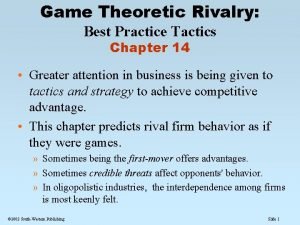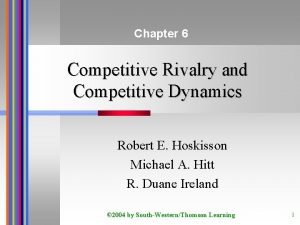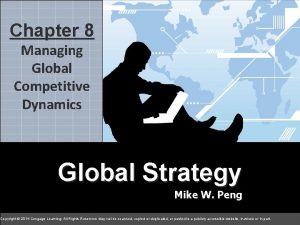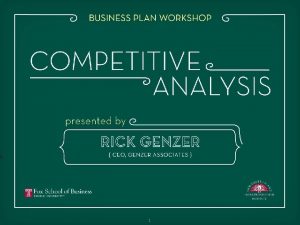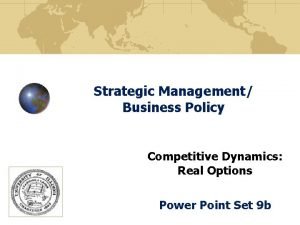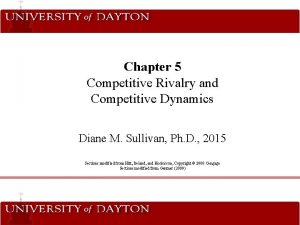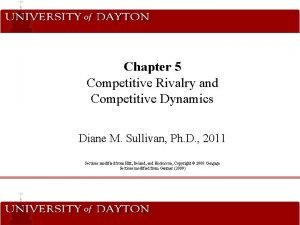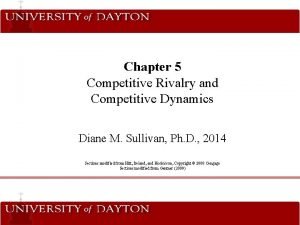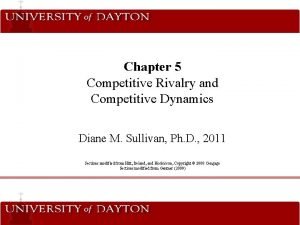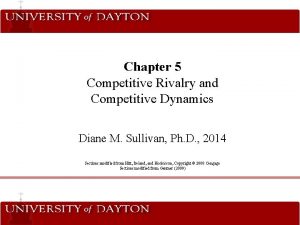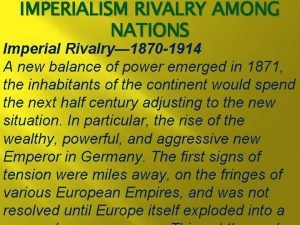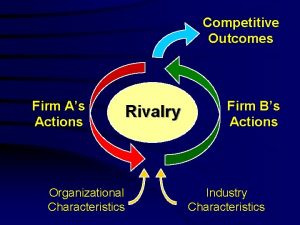Chapter 5 Competitive Rivalry and Competitive Dynamics Diane



















- Slides: 19

Chapter 5 Competitive Rivalry and Competitive Dynamics Diane M. Sullivan, Ph. D. , 2010 Sections modified from Hitt, Ireland, and Hoskisson, Copyright © 2008 Cengage Sections modified from Gentner (2009)

The Strategic Management Process • After selecting a business-level strategy, firms must remain aware of competitive rivalry and dynamics that affect the success of their competitive actions and that allow them to predict competitor’s actions Insert figure 1. 1 graphic

Competitive Rivalry and Dynamics: Key Definitions • Competitors – Firms operating in the same market, offering similar products and targeting similar customers • Competitive Rivalry (firm-to-firm competitive actions) – Ongoing set of actions and responses occurring between competitors as they contend with each other for an advantageous market position – Also called interfirm rivalry • Competitive Dynamics (sum of all firm competitive actions) – Total set of actions and responses of all firms competing within a market • Strategic Action – Significant commitment of a specific and distinctive resource that is irreversible (Boeing’s midsized jet liner; Guess positioning to be more upscale) • Tactical Action – Commitment of less specific resources, taken to fine-tune a strategy, that is reversible (e. g. , pricing, advertising)

Competitive Rivalry and Dynamics: Examples • Ex. 1: The “Dell way”: bypass middle-man and sell custom-built computers directly to consumer – This business model lowered costs and hence prices of products – But as of 2006, no longer created value to the degree it had and • End of 2006: HP 18. 1% vs. Dell’s 14. 7% market share Why? • Ex. 2: Fast food industry

The Essence of Competitive Action and Response Industry Environment Company ‘A’ (e. g. , Starbucks) Initiates Competitive Action Industry Environment is Changed Company ‘B’ (e. g. , Mc. Donald’s) Initiates Competitive Response Industry Environment is Changed Again

The World Automobile Industry: Strategic Groups High Ferrari Lamborghini Porsche Mercedes* BMW Price Toyota Ford General Motors Chrysler* Honda Nissan Hyundai Kia High Low Breadth of Product Line * Chrysler and Mercedes (part of Diamler. Chrysler) are separated for purposes of illustration. Note: Members of each strategic group are only illustrative – not inclusive.

Cap. Sim and Strategic Groups Low Size Perf. Trad Size High Performance

A Model of Competitive Rivalry

Step 1: Conduct General Competitive Analysis • Purpose: assess similarity of firms to determine the extent to which they are competitors • Two components Market Commonality Resource Similarity Extent of Competitive Rivals

Market Commonality and Resource Similarity • Market Commonality (MC) – Increases when firms compete in similar markets – The more overlapping markets (e. g. , multimarket competition), the higher the MC • E. g. , geographic, product, customer, etc. • Mc. Donald’s and Burger King: High MC • Resource Similarity (RS) – How comparable are competitor’s tangible and intangible resources in type and amount? – Fed. Ex and UPS: high RS

Market Commonality and Resource Similarity (Con’t) • Firms should be less inclined to attack a firm that is likely to retaliate – High MC and RS should reduce likelihood of attack • Firms with high MC and with similar resources are more likely to be aware of each other’s competitive moves • When attacked, similar firms more likely to aggressively retaliate – Can lock firms into mutually destructive competitive situations » Fast food industry participants » Netflix and Blockbuster

Step 2: Study Drivers of Competitive Behavior • Awareness – Are managers aware of and do they understand key competitors? • Motivation – Does the firm have an “incentive” to take action or respond? • Ability – Does the firm have the necessary resources to attack? • Understanding competitor’s awareness, motivation and ability helps the firm to predict competitor behavior

Step 3: Examine Likelihood of Attack & Response • Likelihood of Attack (Lo. A) Factors – First-mover advantages—innovative actions can create competitive advantages. Can result in: • 1) customer loyalty and 2) above-average market share • Be cautious of 2 nd movers who can imitate at 65% of the cost of 1 st movers – Organizational Size • Small firms are nimble/flexible so can more quickly act with a variety of actions; • Large firms actions are more numerous, but often predictable

Step 3: Examine Likelihood of Attack & Response • Likelihood of Response (Lo. R) Factors – A firm is likely to respond when the competitor’s action 1. Might produce a stronger competitive advantage for them 2. Damages the firm’s ability to create/maintain an advantage 3. The firm’s market position is less defensible – Three Factors to consider: 1. Type of competitive action 2. Reputation 3. Market dependence

Competitive Dynamics • Competitive Dynamics concern actions and responses among all firms in a market • Deal with the relative competitive speed in different markets – Slow-cycle – Standard-cycle – Fast-cycle • Different speeds, or cycles, will affect competitive behavior (actions and responses)

Competitive Dynamics Continued • Slow-cycle markets – Often shielded from imitation due to costs and/or very strong brand loyalties – May lead to SCA, but eventually it will erode over time • Pharmaceuticals

Slow-cycle Market Gradual Erosion of SCA Returns from a Sustained Competitive Advantage (SCA) Exploitation Counterattack Launch Time (years) 10

Competitive Dynamics Continued • Standard-cycle markets – Lead to highly competitive pressures despite world class products – Multimarket competition may dampen rivalry somewhat – SCA is possible • Fast-cycle markets – Intensely dynamic; 1 st mover advantage unsustainable – Firms may cannibalize older generation products – SCA unlikely

Developing Temporary Advantages to Create Sustained Advantage in Fast- and Standard-Cycle Markets
 Slow cycle market
Slow cycle market Rivalry chapter 14
Rivalry chapter 14 Rivalry ch 6
Rivalry ch 6 Lesson 4 rivalry in north america
Lesson 4 rivalry in north america Rivalry chapter 6
Rivalry chapter 6 Rivalry chapter 5
Rivalry chapter 5 Rivalry 1 chapter 17
Rivalry 1 chapter 17 Rivalry chapter 11
Rivalry chapter 11 Entrepreneurial strategy and competitive dynamics
Entrepreneurial strategy and competitive dynamics Competitive and non competitive antagonist
Competitive and non competitive antagonist Rivalry between the french and the british
Rivalry between the french and the british Childhood rivalry in bali and new guinea
Childhood rivalry in bali and new guinea Managing global competitive dynamics
Managing global competitive dynamics Competitive dynamics
Competitive dynamics Competitive dynamics in strategic management
Competitive dynamics in strategic management What is the least competitive market structure
What is the least competitive market structure English french rivalry
English french rivalry Bioleaching advantages and disadvantages
Bioleaching advantages and disadvantages Global strategic rivalry theory of international trade
Global strategic rivalry theory of international trade Contoh barang eksklusif
Contoh barang eksklusif

